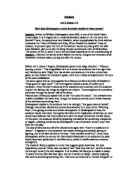“My hands are of your colour; but I shame to wear a heart so white." She means that her hands are red (reference to the blood) too, but that she would be ashamed to have a heart as white (filled with guilt) as Macbeth's. It goes to show you how cold hearted Lady Macbeth is. The oxymoron has the effect of forming interest, creativity, tension and depth to a sentence and gives the play an uneasy atmosphere.
Moreover, colour plays a special role in setting the atmosphere. Red, of course is very important because of the amount of blood in the play. It is also used to signify guilt, rage and hell. The reason it plays a big part is because both Macbeth and Lady Macbeth talk about the 'red misty hell' a lot and it makes the audience feel ‘perturbed’ and uncomfortable with the constant references to hell.
Additionally, Shakespeare used onomatopoeias. Onomatopoeias refer to the use of words which sounds like the word they refer to. For example, Shakespeare used the word ‘hissed’ ‘shrieked’ and ‘clattered’. The auditory aspect of the narrative is enhanced and the reader is more likely to perceive the sounds in his or her head; which is very effective because the audience can interpret the sound their own imagination which doesn’t limit the ways it can be expressed.
As well as this, noise also gives quite a tense atmosphere in the play. When Macbeth goes to kill Duncan, Lady Macbeth hears a ‘knell’ (a traditional funeral bell) and ‘the owls shriek and crickets cry’. Lady Macbeth takes that as a good omen, because the screech owl is nature’s own ‘fatal bellman’. A ‘fatal bellman’ would emphasize the idea of death/ execution in the audience’s minds, which makes it all the more eerie.
However, it makes Macbeth think that more people know about what he has done. Also when Macbeth and Lady Macbeth are talking after the murder, there is a knocking which gives a very uneasy and tense feel: ‘Whence is that knocking? How is't with me, when every noise appalls me?’ As the play goes on, Macbeth becomes very paranoid about any noise and it makes the play feel apprehensive.
Ultimately, the emotions depicted by the characters are one of the most prominent factors of the suspense and tension made in these scenes. Even the way Lady Macbeth was haranguing Macbeth into killing Duncan because of her greed for power forms friction.
Furthermore, the reluctance of Macbeth to kill Duncan is tense. For example, Macbeth said,
“It is bloody business which informs thus to mine eyes,” which means, thoughts of murder are playing on his mind. Therefore proving that Macbeth is reluctant to kill and even the mere thought of killing Duncan is enough to make him ill. This is using the hesitant and tense feelings of Macbeth to connect with the audience and make them feel the same way.
Lastly, Lady Macbeth's opening soliloquy creates attention as the audience see her alone, pacing up and down in a nervous but excited state, awaiting Macbeth's return which increases the tension dramatically. We can see the different side to Lady Macbeth's character at this moment as she appears to be more vulnerable. In this particular part of this scene has to be the climax of the play. When Macbeth and his wife are re-united they are both highly charged with nervous energy and excitement ‘. Macbeth and his wife at first do not speak in sentences. Their speech is syncopated (strengthened) and highly charged emotions tell the audience all is not well. The fact that Macbeth still has hold of the daggers ( ‘Why did you bring these daggers from the place?’) intensifies the tension felt in the scene. His hands would be covered in blood, which would make the drama explosive.
Macbeth however, describes the horrors of the murder and cannot seem to believe he has killed his beloved king: “I'll go no more: I am afraid to think what I have done; Look on't again I dare not.”
In conclusion, Act 2 scenes 1 and 2 were full of tension and suspense and Shakespeare used a range of literary devices to help conjure this feeling up. Also, I think it is interesting that Shakespeare chooses to have Macbeth kill Duncan offstage. We can only guess why he wrote the scene that way, I think that Shakespeare wanted to focus not on the murder but on Macbeth’s reaction to it; the bloody details supplied by the audiences imaginations will be much worse than anything that could be done onstage. I think the murder was committed at night to add to the dark and succumbing atmosphere; I feel the darkness represents what is unnatural, cruel and evil. Everything that happens within the play appears to revolve around this particular scene. Not only is this important because it contains the murderous act, it also conveys to the audience the rapid break down of the relationship between Macbeth and Lady Macbeth.







